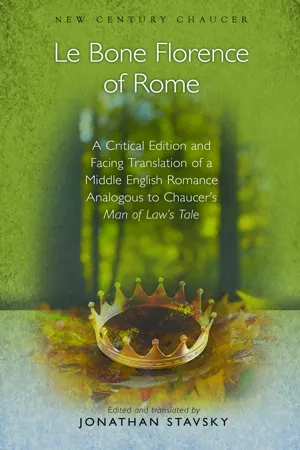
Le Bone Florence of Rome
A Critical Edition and Facing Translation of a Middle English Romance Analogous to Chaucer's Man of Law's Tale
- 304 pages
- English
- ePUB (mobile friendly)
- Available on iOS & Android
Le Bone Florence of Rome
A Critical Edition and Facing Translation of a Middle English Romance Analogous to Chaucer's Man of Law's Tale
About this book
Le Bone Florence of Rome is a Middle English tail-rhyme romance whose unique copy dates to the late fifteenth century. An analogue of Chaucer's Man of Law's Tale, it follows the adventures of a heroine who survives multiple exiles, sexual harassments and false accusations. At the same time, it explores such issues as the abuse of power, the stakes of global conflict, women's place in society and their control over their destiny, all of which are treated in significantly different ways from the Constance story and other medieval tales of calumniated women. This fresh edition is accompanied by a complete line-by-line translation, which makes this text accessible to readers at all levels. Its introduction offers a comprehensive analysis of the themes, ideologies and literary relationships of the romance, together with new insights into its local connections and a detailed description of its manuscript context.
Frequently asked questions
- Essential is ideal for learners and professionals who enjoy exploring a wide range of subjects. Access the Essential Library with 800,000+ trusted titles and best-sellers across business, personal growth, and the humanities. Includes unlimited reading time and Standard Read Aloud voice.
- Complete: Perfect for advanced learners and researchers needing full, unrestricted access. Unlock 1.4M+ books across hundreds of subjects, including academic and specialized titles. The Complete Plan also includes advanced features like Premium Read Aloud and Research Assistant.
Please note we cannot support devices running on iOS 13 and Android 7 or earlier. Learn more about using the app.
Information
Table of contents
- Cover
- Title Page
- Copyright Page
- Dedication
- Contents
- Acknowledgements
- List of Abbreviations
- Introduction
- Le Bone Florence of Rome
- Appendix 1: Marginalia
- Appendix 2: Middle English Words and Idioms Discussed in the Explanatory and Textual Notes
- Appendix 3: Names and Places
- Index to the Introduction and Explanatory Notes